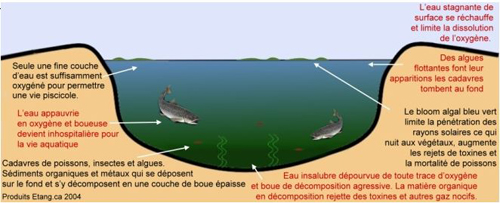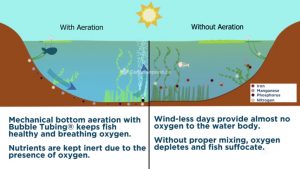Ponds and Eutrophication
The Eutrophication Process
Whether it is of natural origin or it was dug on your property, a pond can sometimes show signs of “poor health” and eutrophication. Odors, poor water quality, mud on the bottom or the death of fish are all warning signs of imbalances. The factors that cause these kinds of symptoms are often natural: a particularly dry year can lead to a significant drop in the water level which in turn can cause changes that will worsen over time if no action is taken to remedy it. Likewise, a very rainy season can lead to increased sedimentation of organic matter from the leaching of the banks, which when decomposing consumes a large quantity of the water’s oxygen reserves.
Note that any pond or lake will eventually age, fill with mud and turn into a swamp, then into a wetland and finally into undergrowth. This is a natural process occurring over hundreds or thousands of years, depending on the size of the body of water. A large lake may take thousands of years to fill, while a small water garden will fill up after two years.
Aquatic Pollution
The problem arises when anthropogenic factors significantly accelerate this process. The large amount of nutrients and pollution present in the runoff increases the productivity algae and aquatic plants in lakes. When these die, they turn into more muck that accumulates at the bottom, furthermore increasing the amount of nutrients, and so on, in a positive feedback loop that matures the body of water. When a certain criteria of nutrient concentrations, vegetation cover and episodes of algae are observed, we have a eutrophic lake.
There are two types of aquatic pollution: soluble and insoluble. Lakes accumulate insoluble solid matter such as dead plants or animal remains. Soluble pollutants, mainly coming from fertilizers, erosion and seepage, provide phosphorus and nitrogen to algae and invasive vegetation.
Large amounts of mud, not necessarily visible from the bank, can accumulate at the bottom of your pond. This can consume all the oxygen necessary for chemotrophic organisms, and therefore produce undesirable compounds such as ammonia and hydrogen sulphide. There is also a release of phosphorus, which is usually reused by plants. The plants suffocate and are then replaced by less demanding algae which by proliferating will disrupt the functioning of your pond.
When people realize that their pond is filling up with organic matter and other sediment, their first instinct is to think of regrooving the pond. But there are other cheaper and more importantly, less traumatic solutions to restore the balance of the ecosystem of your lake or pond. Regrooving a pond is only a temporary solution to these sedimentation problems, and mud build-up is just a symptom of the lack of oxygen in your water. Adding an aeration system to your lake, gravel pit or pond remains the solution to many sometimes discouraging problems. 
Insufficiently Oxygenated, a Pond Can Age Prematurely and Disappear
Aquatic life is closely linked to the quality of the water. To survive, any organism inhabiting a pond, canal or basin is dependent on various factors. Oxygen is the most important of them. In a pond, the oxygen level can be greatly affected by an algal bloom or chemical reactions linked to the leaching of organic pollutants. The oxygen thus consumed is no longer accessible to the beneficial organisms represented by fish and other aquatic plants serving as food for their prey. As the oxygen level decreases, these organisms find it more and more difficult to survive and tend to become extinct. They are then replaced by algae: we are witnessing the eutrophication of the pond. The death of the pond or lake is the next step.
One type of phytoplankton, the blue-green algal bloom (cyanobacteria), typically appears during the spring or fall when nutrient amounts are greatest. The nutrient-enriched runoff water or any other source (even pollution) promotes the development and reproduction of these algae which give the water a sticky and dirty appearance. The oxygen consumed during their life cycle, but also for their decomposition is lacking for the other organisms inhabiting the body of water, which leads to drops in density of fish and other living beings.

Filamentous algae, also called “pond scum”, form thick braids and aggregate in dense, floating clusters. Their growth begins from submerged objects or rocks at the bottom of the pond. As they grow, algae release oxygen which is trapped in the center of plant clusters. This gives the clusters a buoyancy which carries them to the surface where they then cover large areas. The problem of filamentous algae is often a persistent problem because these plants have the particularity of reproducing from plant fragments, spores or by cell division. Treatment with good bacteria can help solve this problem.
Adding Aeration to a Pond or Lake – the Best Way to Control Water Quality and Algae
We offer two types of oxygenation systems. The electrical system consists of varying sizes of diffusers and compressors to aerate ponds and lakes ranging from half an acre up to 8 acres. The second type of system is powered by solar energy and does not require an electrical source. 
The solar panels activate the compressor which sends pressurized air to the diffusers. These are easy to install at the bottom of the pond. In periods with too much snow, limited solar radiation or where continuous ventilation is required, we recommend the electrical system. The electrical system provides optimal ventilation whatever the weather or the season.
Don’t hesitate to get in touch with our team of experts to learn more!